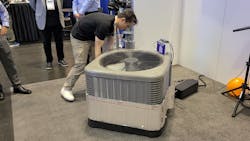No Overheating with AI-Enabled Sensors on the Edge
Check out our Sensors Converge 2023 coverage.
Renesas Electronics wants you to use machine learning on the edge to protect things like air-conditioning systems (see figure). In the company’s demo, a running air-conditioning condenser was wrapped so that the system would begin to overheat. Renesas’ microcontroller was running a small machine-learning/artificial-intelligence (ML/AI) model that does a “Reality check HVAC.” Thus, it’s more than just a temperature tripwire—it’s also a self-diagnosing unit.
In the demo, Renesas employees wrapped an air-conditioning system to simulate an overheating condition that was recognized by the machine-learning application running on a Renesas microcontroller.
I talked with Stuart Feffer, Head of Real-Time-Analytics and Reality AI at Renesas, about the company’s edge AI software that targets microcontrollers.
The software is a portion of the Reality AI and RealityCheck AD for Industrial Anomaly Detection software support. Much of this was part of the Reality Analytics acquisition that brings ML solutions to edge computing, especially for small microcontrollers that are used for sensor applications and motor control.
The software support automatically generates a baseline anomaly-detection model. The model is then used to build up and train models that can predict and detect specific faults like an overheated air-conditioning condenser.
Unlike video-processing ML models that require hefty processors and often AI accelerators, this software is designed for low-power, lower-performance systems that check sensors and control motors. The small footprint models are built using ML optimization techniques like quantization, compression, and pruning. The models use small integers to keep size down and limit processor performance requirements.
Check out more of our Sensors Converge 2023 coverage.
Links
About the Author
William G. Wong
Senior Content Director - Electronic Design and Microwaves & RF
I am Editor of Electronic Design focusing on embedded, software, and systems. As Senior Content Director, I also manage Microwaves & RF and I work with a great team of editors to provide engineers, programmers, developers and technical managers with interesting and useful articles and videos on a regular basis. Check out our free newsletters to see the latest content.
You can send press releases for new products for possible coverage on the website. I am also interested in receiving contributed articles for publishing on our website. Use our template and send to me along with a signed release form.
Check out my blog, AltEmbedded on Electronic Design, as well as his latest articles on this site that are listed below.
You can visit my social media via these links:
- AltEmbedded on Electronic Design
- Bill Wong on Facebook
- @AltEmbedded on Twitter
- Bill Wong on LinkedIn
I earned a Bachelor of Electrical Engineering at the Georgia Institute of Technology and a Masters in Computer Science from Rutgers University. I still do a bit of programming using everything from C and C++ to Rust and Ada/SPARK. I do a bit of PHP programming for Drupal websites. I have posted a few Drupal modules.
I still get a hand on software and electronic hardware. Some of this can be found on our Kit Close-Up video series. You can also see me on many of our TechXchange Talk videos. I am interested in a range of projects from robotics to artificial intelligence.

